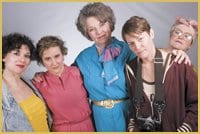Leaping Thespians director Karen White read over 50 scripts before 8 x 10 Glossy caught her eye.
To her, the play’s myriad themes — sexuality, political activism, and family dysfunction — felt particularly relevant for a 2008 audience, even one steeped in modern liberations.
Written by Sarah Dreher, 8 x 10 Glossy is set in 1984. At its centre is Carter, a lesbian activist and photojournalist, who returns home on the one-year anniversary of her father’s death to face her sister, Julie, a repressed and unhappy housewife, and her mother, Kettie, finally free after years of abuse. Julie’s attractive new friend, Lisa, and the unseen nosy neighbour round out the cast.
Having come out herself in 1978, White strongly identifies with the sexual themes the play explores, and recalls the struggles facing the lesbian community during that pivotal time.
“The majority of people were against gays at the time,” White explains. “I knew many women on the fringe of the lesbian-feminist community who didn’t call themselves lesbian; they ‘just happened to be in love with a women.’ It was still very much the love that dare not speak its name, except in the safe enclaves of lesbian culture: the bars, softball teams, and many feminist organizations.”
Times have changed but modern audiences will likely be able to draw many comparisons between then and now, White suggests.
“Every young woman coming out now, even though she’s coming out in a different world, wants the approval of her family. Lots of women now, even though they know it’s okay to be a lesbian, still don’t think they are. They’re surprised by feelings for a woman.”
In 8 x 10 Glossy, Carter may be out and proud, but she’s still desperate for Julie’s approval. Julie, afraid of her own feelings for Lisa, can’t help but lash out at Carter.
The sisters’ relationship is complicated, fraught with expectation and disappointment, but the underlying love between the siblings fuels every scene.
Taylor Stutchbury plays Julie and is empathetic to the struggles her character faces in confronting her sexuality.
“I was closer to Carter in realizing my orientation, yet sexuality is something which has evolved for me over time and it is there where I can understand Julie’s struggle,” Stutchbury says. “Sexuality for me has to do with acceptance of yourself. Julie’s internalized homophobia is something I struggled with when I was younger and it still pokes out its head as I age.”
“Women who proclaimed their lesbianism often lost custody of their children, a theme only alluded to in this story but a strong undercurrent,” White points out, noting the potential costs of coming out for Julie are not the same as for her sister.
“For Julie, being a favoured young mom in the town, getting her identity from others, doing what is expected of her is second nature,” White explains. “So many women lost close connections with family after coming out, there was a lot to lose. A lot to lose especially if you are not sure, and how can you be sure until you try?”
Eroca Zales, who plays Kettie, sees an ugly similarity between 8 x 10’s 1984 politics and the current political condition. She recounts a pivotal scene where Carter likens the persecution of gays to the holocaust, and asks, “It’s happening again, isn’t it?”
“Of course that is happening now in the States with the Christian right,” Zales says. “It’s a very dangerous political movement. Very repressive to many people — women’s right to choose, gays, Muslims, on and on.”
Like many plays that prove timeless, 8 x 10’s gift is Dreher’s dialogue: honest and unpretentious, with plenty of moments of dark wit, tense confrontation, and cute flirting.
We’re introduced to Carter and Lisa within minutes of the curtain rising. Lisa is obviously at home in Kettie’s backyard, and Carter is intrigued by the stranger who seems so close to her sister. The two women who are competing for Julie’s affections circle each other with caution, friendship, and a spark of attraction.
Great dialogue also propels the rise and fall of the heated exchanges between Carter and Julie as they butt heads and then back down, only to keep the pattern on repeat.
Leigh Burrows plays Carter, and while she acknowledges the play touches on important issues about sexuality, she feels the main focus is family.
“What makes the story universal is the way the family interacts, the way we keep up appearances,” Burrows says. “Even though there is all this stuff that goes on behind the scenes and behind all the closed doors.”
“When I first told one of my sisters that I was a lesbian, it was in a public place in Fredericton, New Brunswick. At the time she worried about [what] people would think when she gave me a hug,” Stutchbury recalls. “Years later she came out as a lesbian and it gave me better understanding about what had been going on for her.”

 Why you can trust Xtra
Why you can trust Xtra


